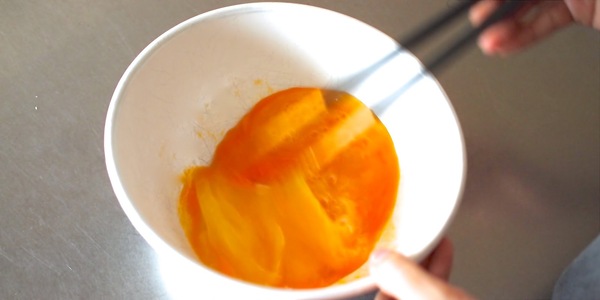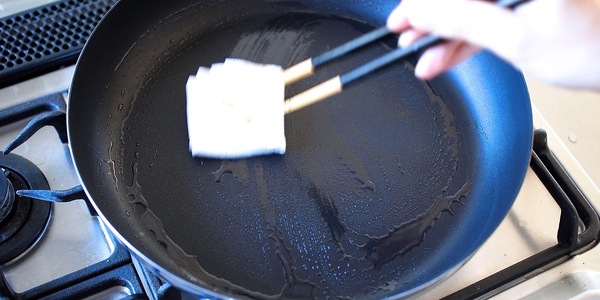
Tamagoyaki is Japanese omelette, also called Atsuyaki Tamago that is made of eggs, sugar and soy sauce. It tastes a little bit salty-sweet. Dashimaki Tamago is a dish recipe just like Tamagoyaki, but the ingredients and taste are a little different.
Dashimaki Tamago has a strong dashi flavor, and It’s quite softer than Tamagoyaki. Both of them (Tamagoyaki and Dashimaki Tamago) are popular for breakfast, lunch bento box, sushi topping, and other side dishes.
The process of making Dashimaki Tamago is similar to Tamagoyaki. Using a specialized Tamagoyaki pan makes it easier, but don’t worry if you don’t have one! We’ll show you how to make it using a regular round pan. If you prefer a fluffy, soft texture, Dashimaki Tamago is the way to go.
However, the rolling technique for Dashimaki Tamago can be slightly trickier due to the extra moisture it has.
But don’t worry, with just a little practice, you’ll become very skilled at making it, for sure.
Tamagoyaki Recipe & Dashimaki Tamago







Tips and Tricks
Making Tamagoyaki requires a delicate balance of technique and timing, so we’ll share some tips and tricks to help you master this traditional Japanese dish:
-
- Properly season your pan: Before cooking, ensure your pan is well-seasoned or use a non-stick pan to prevent the egg from sticking.
- Control the heat: Adjust the heat to medium-low to prevent the egg from burning and to achieve a perfectly cooked omelette.
- Adjust seasoning to taste: Tamagoyaki can be sweet or savory depending on your preference. Experiment with different levels of sugar and soy sauce to find your perfect balance.
- Incorporate air: To achieve a light and fluffy texture, gently incorporate air into the egg mixture while cooking.
- Use a bamboo mat: A bamboo mat or paper towel can help you roll and shape the Tamagoyaki easily without breaking it.
Variations
While traditional Tamagoyaki is delicious on its own, you can customize it to suit your taste preferences. A few creative variations to try:
-
- Add diced vegetables: Enhance the flavor and texture of your Tamagoyaki by adding diced vegetables like bell peppers, onions, or mushrooms.
- add protein: Boost the protein content of your Tamagoyaki by adding cooked shrimp, crab, bacon, or ham.
- Explore vegetarian options: For a vegetarian or vegan alternative, consider using tofu as a base or substituting eggs with chickpea flour.
- Experiment with seasonings: Get creative with seasonings by using soy sauce, mirin, or furikake to add depth and complexity to your Tamagoyaki.
- Try different fillings: Experiment with different fillings like cheese, nori, or even kimchi to create unique flavor combinations.
A sweet Tamagoyaki recipe that’s perfect for a delightful breakfast or a tasty snack
Ingredients:
- 4 large eggs
- 2 tablespoons sugar
- 1 tablespoon mirin (Japanese sweet rice wine)
- 1 tablespoon soy sauce
- 1/4 teaspoon vanilla extract
- Butter or oil for cooking
Instructions:
- In a mixing bowl, crack the eggs and add sugar, mirin, soy sauce, and vanilla extract.
- Whisk the ingredients together until well combined and the sugar has dissolved.
- Heat a Tamagoyaki pan or a non-stick frying pan over medium-low heat. Add a small amount of butter or oil to coat the pan.
- Pour a thin layer of the egg mixture into the pan, tilting it to spread the mixture evenly.
- Once the bottom layer has set but is still slightly runny on top, gently roll it up from one end of the pan to the other using chopsticks or a spatula.
- Push the rolled egg to one side of the pan and add another thin layer of the egg mixture to the empty side. Lift the rolled egg and let the new layer flow underneath it.
- Once the new layer has set, roll it up again with the existing egg roll. Repeat this process until all the egg mixture has been used.
- Remove the rolled Tamagoyaki from the pan and let it cool slightly before slicing it into bite-sized pieces.
- Serve the sweet Tamagoyaki warm or at room temperature. Enjoy!
Feel free to adjust the sweetness of the Tamagoyaki by adding more or less sugar according to your taste preferences.
You can also experiment with different flavorings such as cinnamon or nutmeg for a unique twist on this classic Japanese dish.
Serving Suggestions
It’s a dish that can be enjoyed in various ways. Check some serving suggestions to inspire your culinary creativity:
-
- Traditional presentation: Slice it into bite-sized pieces and serve with a dipping sauce made from soy sauce and grated daikon radish.
- Modern twists: Use Tamagoyaki as a filling for sandwiches or sushi rolls for a contemporary twist on this classic dish.
- Pairing options: Serve alongside steamed rice, miso soup, and pickled vegetables for a complete Japanese meal.
- Bento box ideas: Pack it into bento boxes or lunchboxes for a convenient and satisfying meal on the go.
- Standalone dish: Enjoy Tamagoyaki on its own as a delicious appetizer or snack, perfect for any occasion.
Wrapping up!
Tamagoyaki is more than just a simple egg dish—it’s a culinary delight that embodies the rich tradition of Japanese cuisine. With a few simple techniques and a touch of creativity, you can transform humble eggs into a masterpiece of flavor and texture.
Whether you’re a novice cook or a seasoned chef, Tamagoyaki offers endless possibilities for experimentation and enjoyment.
So, why not try making this yummy Tamagoyaki recipe at home today? Explore different variations, serving suggestions, and flavor combinations to create your own Japanese culinary creation.